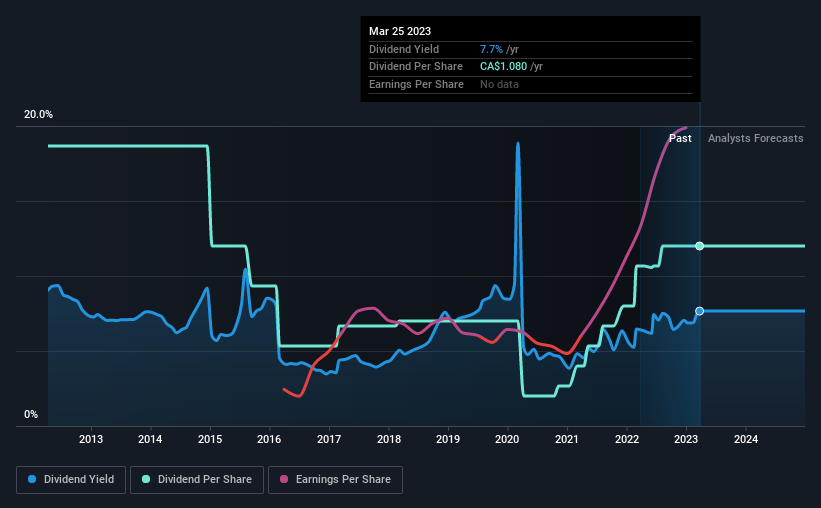Interested In Freehold Royalties' (TSE:FRU) Upcoming CA$0.09 Dividend? You Have Four Days Left
It looks like Freehold Royalties Ltd. (TSE:FRU) is about to go ex-dividend in the next 4 days. The ex-dividend date is one business day before the record date, which is the cut-off date for shareholders to be present on the company's books to be eligible for a dividend payment. The ex-dividend date is an important date to be aware of as any purchase of the stock made on or after this date might mean a late settlement that doesn't show on the record date. This means that investors who purchase Freehold Royalties' shares on or after the 30th of March will not receive the dividend, which will be paid on the 17th of April.
The company's next dividend payment will be CA$0.09 per share, and in the last 12 months, the company paid a total of CA$1.08 per share. Looking at the last 12 months of distributions, Freehold Royalties has a trailing yield of approximately 7.7% on its current stock price of CA$14.1. If you buy this business for its dividend, you should have an idea of whether Freehold Royalties's dividend is reliable and sustainable. So we need to check whether the dividend payments are covered, and if earnings are growing.
See our latest analysis for Freehold Royalties
Dividends are typically paid from company earnings. If a company pays more in dividends than it earned in profit, then the dividend could be unsustainable. Freehold Royalties paid out more than half (70%) of its earnings last year, which is a regular payout ratio for most companies. That said, even highly profitable companies sometimes might not generate enough cash to pay the dividend, which is why we should always check if the dividend is covered by cash flow. It paid out 104% of its free cash flow in the form of dividends last year, which is outside the comfort zone for most businesses. Companies usually need cash more than they need earnings - expenses don't pay themselves - so it's not great to see it paying out so much of its cash flow.
While Freehold Royalties's dividends were covered by the company's reported profits, cash is somewhat more important, so it's not great to see that the company didn't generate enough cash to pay its dividend. Cash is king, as they say, and were Freehold Royalties to repeatedly pay dividends that aren't well covered by cashflow, we would consider this a warning sign.
Click here to see the company's payout ratio, plus analyst estimates of its future dividends.
Have Earnings And Dividends Been Growing?
Stocks in companies that generate sustainable earnings growth often make the best dividend prospects, as it is easier to lift the dividend when earnings are rising. Investors love dividends, so if earnings fall and the dividend is reduced, expect a stock to be sold off heavily at the same time. That's why it's comforting to see Freehold Royalties's earnings have been skyrocketing, up 68% per annum for the past five years. Earnings have been growing quickly, but we're concerned dividend payments consumed most of the company's cash flow over the past year.
Many investors will assess a company's dividend performance by evaluating how much the dividend payments have changed over time. Freehold Royalties's dividend payments per share have declined at 4.3% per year on average over the past 10 years, which is uninspiring. It's unusual to see earnings per share increasing at the same time as dividends per share have been in decline. We'd hope it's because the company is reinvesting heavily in its business, but it could also suggest business is lumpy.
To Sum It Up
Is Freehold Royalties an attractive dividend stock, or better left on the shelf? It's good to see that earnings per share are growing and that the company's payout ratio is within a normal range for most businesses. However we're somewhat concerned that it paid out 104% of its cashflow, which is uncomfortably high. To summarise, Freehold Royalties looks okay on this analysis, although it doesn't appear a stand-out opportunity.
If you're not too concerned about Freehold Royalties's ability to pay dividends, you should still be mindful of some of the other risks that this business faces. To that end, you should learn about the 2 warning signs we've spotted with Freehold Royalties (including 1 which is significant).
Generally, we wouldn't recommend just buying the first dividend stock you see. Here's a curated list of interesting stocks that are strong dividend payers.
Have feedback on this article? Concerned about the content? Get in touch with us directly. Alternatively, email editorial-team (at) simplywallst.com.
This article by Simply Wall St is general in nature. We provide commentary based on historical data and analyst forecasts only using an unbiased methodology and our articles are not intended to be financial advice. It does not constitute a recommendation to buy or sell any stock, and does not take account of your objectives, or your financial situation. We aim to bring you long-term focused analysis driven by fundamental data. Note that our analysis may not factor in the latest price-sensitive company announcements or qualitative material. Simply Wall St has no position in any stocks mentioned.
Join A Paid User Research Session
You’ll receive a US$30 Amazon Gift card for 1 hour of your time while helping us build better investing tools for the individual investors like yourself. Sign up here

 Yahoo Finance
Yahoo Finance 
